Freshwater is a national park in Queensland, Australia, 34 km north of Brisbane. The park is west of Redcliffe, near Deception Bay, within Caboolture Shire.

A dry lake bed, also known as a playa, is a basin or depression that formerly contained a standing surface water body, which disappears when evaporation processes exceed recharge. If the floor of a dry lake is covered by deposits of alkaline compounds, it is known as an alkali flat. If covered with salt, it is known as a salt flat.
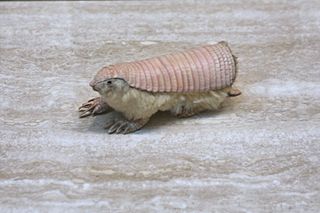
The pink fairy armadillo is the smallest species of armadillo, first described by Richard Harlan in 1825. This solitary, desert-adapted animal is endemic to central Argentina and can be found inhabiting sandy plains, dunes, and scrubby grasslands.

Macrolepiota procera, the parasol mushroom, is a basidiomycete fungus with a large, prominent fruiting body resembling a parasol. It is a fairly common species on well-drained soils. It is found solitary or in groups and fairy rings in pastures and occasionally in woodland. Globally, it is widespread in temperate regions.

Calliandra eriophylla, commonly known as fairy duster, is a low spreading shrub which is native to deserts and arid grasslands in California, Arizona, New Mexico, Texas, and Mexico.

Lupinus bicolor is a species of lupine known as the miniature lupine, Lindley's annual lupine, pigmy-leaved lupine, or bicolor lupine.
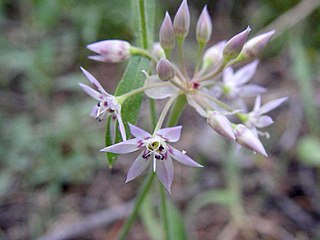
Allium campanulatum is a species of wild onion known by the common name dusky onion or Sierra onion. This is a flowering plant native to the western United States from southeastern Washington and northern Oregon to southern California, and western Nevada. The dusky onion grows in foothills and mountains, especially in dry areas, such as chaparral habitats.
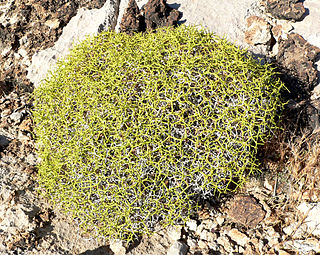
Eriogonum heermannii is a species of wild buckwheat known by the common name Heermann's buckwheat. It is native to the southwestern United States from California to Utah where it grows on rocky slopes, desert flats, and dry washes.
Hesperolinon drymarioides is a rare species of flowering plant in the flax family known by the common names drymary dwarf flax and drymaria-like western flax; it is named for its resemblance to genus Drymaria. It is endemic to California, where it grows in the central inland North Coast Range. Most of the few known occurrences have been noted in Lake County. It is a plant of serpentine soils in chaparral and woodland ecosystems. This is a small annual herb growing a thin branching brown stem low to the ground or erect to about 20 centimeters in height. Leaves appear in whorls of four on the lower part of the stem and are dark reddish green with plentiful glandular hairs. Its flowers have light pink-veined white petals in a corolla about a centimeter across. Protruding stamens hold large yellow or purplish-white anthers.
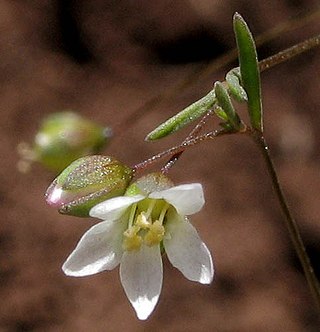
Hesperolinon micranthum is a species of flowering plant in the flax family known by the common name smallflower dwarf flax. It is native to the west coast of North America from Oregon to Baja California. It may occur in Nevada. It grows in a number of open habitats, often on serpentine soils. This is a spindly annual herb producing a very thin stem 5 to 20 centimeters in height. Its small, sparse leaves are linear in shape. The tiny flowers have five white or pink-veined white petals each less than four millimeters long and protruding stamens with white or purple anthers.
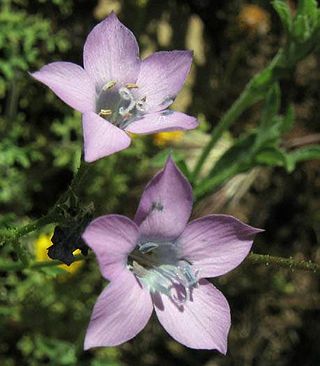
Saltugilia splendens, is a species of flowering plant in the phlox family known by the common names splendid woodland-gilia, Grinnell's gilia and splendid gilia.
Calyptridium pulchellum, synonym Cistanthe pulchella, is a rare species of flowering plant in the family Montiaceae. It is known by the common name Mariposa pussypaws. It is endemic to the Sierra Nevada foothills of central California, where it is known from only a few scattered occurrences. It grows on barren patches of granite gravel in woodland and grasslands. It is a federally listed threatened species.

Tamarix gallica, the French tamarisk, is a deciduous, herbaceous, twiggy shrub or small tree reaching up to about 5 meters high.

Linanthus dianthiflorus is a species of flowering plant in the phlox family known by the common names fringed linanthus and ground pink.
Linanthus orcuttii is an uncommon species of flowering plant in the phlox family known by the common name Orcutt's linanthus. It is known only from southern California and Baja California, where it grows in chaparral and pine forests in the Peninsular Ranges and occasionally the San Bernardino Mountains.
Nemacladus gracilis is an uncommon species of flowering plant in the bellflower family known by the common names slender threadplant or slender nemacladus. It is endemic to California, where it is known from the Transverse Ranges and adjacent mountains, desert, and valley territory. It can be found in rocky and sandy areas in woodland and grassland habitat. It is a small annual herb producing an upright reddish brown stem no more than about 10 centimeters long. Small lobed oval leaves under a centimeter long occur at the base of the plant. The inflorescence is a series of branches bearing occasional flowers on thin, curving pedicels. There is a single tiny bract at the base of each pedicel. The flower is only about 2 millimeters long. It has five lavender-veined white lobes fused along the lower half.
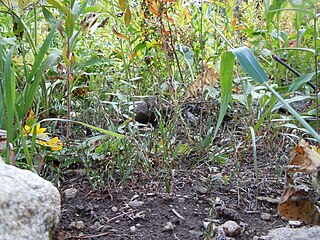
Polygonum douglasii is a species of flowering plant in the knotweed family known by the common name Douglas's knotweed. It is native to much of northern and western North America, where it can be found in many types of habitat, including disturbed areas. It has been found in Canada from British Columbia north to Yukon and east as far as Québec, and in the United States as far south as California, New Mexico, Iowa, and New York.
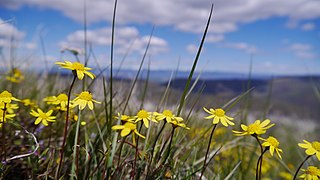
Crocidium is a small North American genus of plants in the daisy family. Crocidium is native to western North America: British Columbia Washington, Idaho, Oregon, and California.

Cuscuta denticulata, commonly known as desert dodder or small-toothed dodder, is a thin, yellow to orange, parasitic annual vine in the morning glory family (Convulvulaceae), native to the deserts of the south-western United States and northern Mexico.
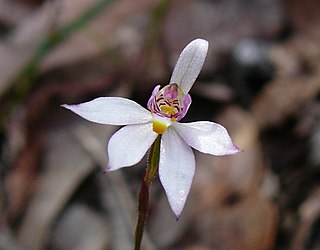
Caladenia alata, commonly known as the fairy orchid, is a plant in the orchid family Orchidaceae and is found in south-eastern Australia and New Zealand. It is a ground orchid with small, usually short-lived flowers, which have relatively stiffly held petals and sepals and reddish-purple bars on the labellum.















